Busuu

Summary
Busuu is a digital language-learning app with over 90 million registered users. The resource offers vocabulary and grammar practice through short, self-paced study exercises. It also has a social aspect that allows users to get writing and pronunciation feedback from native speakers. It is available on the web, iOS, and Android.
The layout is great, and the quality for non-Asian languages is decent, but there were significant errors in the Chinese course.
It has some good explanations but doesn’t often offer much in the way of in-depth explanations.
Busuu is relatively inexpensive, but there are more thorough and efficient resources out there.
I Like
- The layout is easy to use and engaging
- The conversation lessons are especially useful
- The social feature is great
I Don’t Like
- Translations aren’t provided for some exercises.
- The Chinese course is low-quality.
- The grammar explanations and practice could be better.
Price
Premium Subscriptions
One month: $13.95
Six months: $50.70 ($8.45/month)
One Year: $40.70 ($3.48/month)
What Is Busuu?
Boasting a user base of over 90 million, Busuu is a heavyweight in the digital language-learning landscape. It was launched in 2008 and has remained a popular and relatively low-cost option for language learners.
There are 12 languages supported on the platform, and practice opportunities take place in the form of a variety of short activities that make up themed lessons.
One of the areas in which Busuu stands out is its social feature. Users can give and receive writing and pronunciation feedback and add each other as friends.
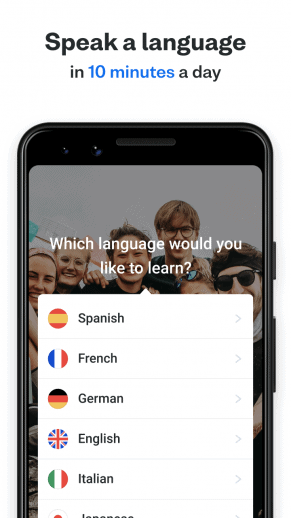
How We Did This Review
To make our Busuu review as comprehensive and fair as possible, multilingual Mateo and I both reviewed the resource independently before meeting up to share and compare our findings.

Mateo:
“I had one previous contact with the German language a couple of years ago that wasn’t very successful. So far, I feel like Busuu has been entertaining. It also seems to be working fine as far as learning the language goes.”

Brian:
“My only previous experience in learning Chinese was through Duolingo. I found it difficult to pick up and retained next to nothing. I’m excited to see if the Chinese Busuu experience is any different and to see if I can’t improve upon my basic Italian skills.”
The final products of this collaborative process are this written review and the video review created by Mateo.
Quick Opinions
Once again, the feelings Mateo and I have about this resource line up pretty closely. Having both also recently reviewed Babbel together, it was also natural to draw lots of comparisons between the two. They have a similar layout and price point, but there are still plenty of differences.
Mateo gave Busuu a slightly higher rating than I did, and part of that probably boils down to our language choices.
We’ll talk about this more later, but Busuu is not recommended for Asian languages. My experience learning Chinese with Busuu was frustrating.
Asian frustrations aside, Mateo and I both agreed that the Busuu layout is easy to use and interactive. It also provides a variety of useful practice exercises, touches on grammar explanations, and has a pretty cool social feature.
We both would have liked to see grammar explanations that were more in-depth and to get better review opportunities for practicing grammar.
I also thought that some exercises just weren’t that effective at teaching the material — I found myself guessing on some questions and not learning from them.
Here are the individual ratings we came up with:
Mateo – 3.7/5 Stars
Brian – 3/5 Stars
Combined final rating: 3.3/5 Stars
Initial Impressions
Mateo and I both definitely had positive first impressions with the platform. The Busuu interface is intuitive, clear and easy to navigate.
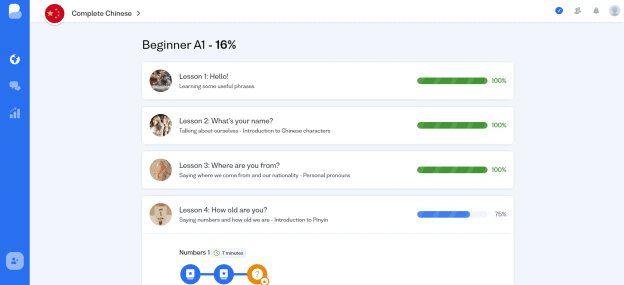
I especially like how the lessons are all laid out. It’s simple and easy on the eyes. It also appears, even at first glance, that the lessons follow a logical progression.
Everything feels nice once you actually get into a lesson as well. Mateo mentioned that he felt like the activities were interactive enough to keep from being boring, and I had similar feelings throughout my first lesson.
I’m not starting from zero with Italian, so I opted to take the placement test.

My experience with placement tests in other resources is that they seem to err on the side of putting you at a level that’s too low. Busuu did a pretty good job; it actually put me at a level that may have been a bit too high. Fortunately, it’s easy enough to skip around and take any lesson at any time.
Lessons
The Lessons section is where you access all of the learning material on Busuu. Lessons follow a logical progression and are grouped into different CEFR levels. One thing I really like about this resource is how easy it is to see your progress.
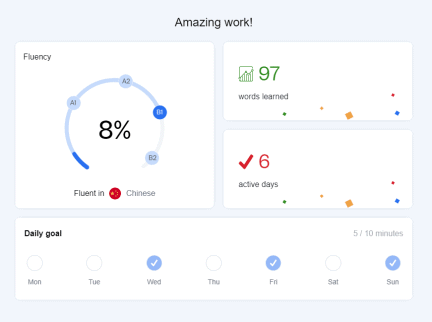
I mostly liked the lesson flow from one topic to another and the gradual scaffolding of material, but it wasn’t perfect.
The way the material in the Chinese course builds on itself was awkward; I found it very difficult to get through some lessons the first time. I ended up blindly guessing at a lot of questions, and even when I got them right I was never shown a translation. Here’s an example:
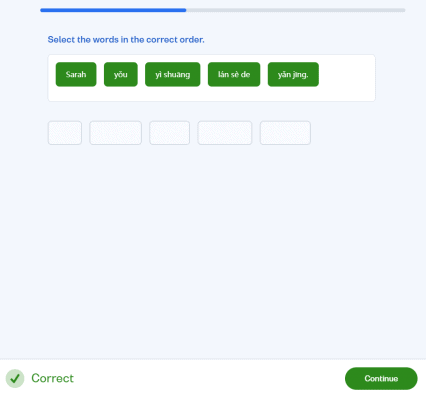
Before this question, I had only been exposed to these words as characters. I also hadn’t had enough exposure to memorize them at all. The capital letter and punctuation mark helped me guess the correct order, but I have no real connection with the material.
This is something that happened with Italian as well. I’m even better at guessing word order in Italian because I can usually identify word types even if I don’t know what they mean. A translation or picture that appears after you answer the question would have been extremely helpful.
I’ll focus more on the experiences Mateo and I had with non-Asian languages because that’s where Busuu works best, and I’ll include more about my Chinese-learning experience towards the end of the review.
Exercises
Most lessons start by introducing you to new vocabulary with a translation, audio recording, and a picture. Your task is simply to “Memorise the word(s).”
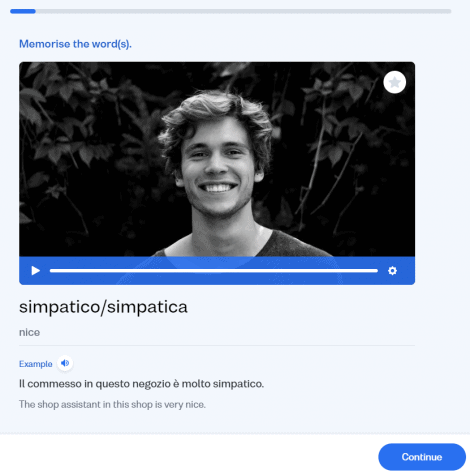
The audio is good here, and that’s a plus. The example sentence and image are nice touches as well. In some lessons, though, I found that there were too many words for me to memorize and was overwhelmed.
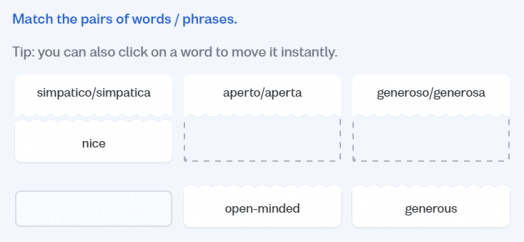
This is an example of a simple matching exercise you’ll go through when first getting acquainted with new material.
There is a variety of these simple exercises that aim at getting you comfortable with the language. You’ll come across fill-in-the-gap exercises, unscramble-the-word/sentence puzzles, and basic listening activities, to name a few.

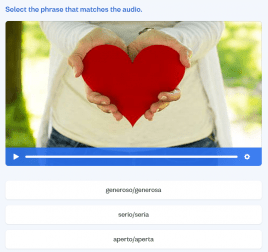
The variety is nice, and it keeps the lesson progression from being too predictable. Mateo and I both agree that this does something to keep the courses from becoming too tedious.
One of our favorite exercises in the lessons is the simulated conversation practice.

Babbel offers something similar, but the Busuu option feels more complex and realistic. Unlike Babbel, this conversation simulation doesn’t stop after each sentence. It plays the whole way through, which makes it feel more natural.
While it’s great that it feels more natural and life-like, I also wished I had the option to pause the recording or to listen to a specific part.
Social
One of the things Busuu offers that a lot of other digital resources don’t is a social aspect. In fact, it’s often said to be the “Largest social network for language learning.”
With a user base topping 90 million, this might just be the case.
This is one of the program’s best features, and it’s partially available for free. With a free membership, you’re able to provide feedback to other users’ posts and to make your own posts for feedback. You won’t, however, be able to use the social feedback feature that comes at the end of each lesson with a paid subscription .
The social feature is nice, but thinking of it as a social network could be misleading. The only way to communicate with other users is through the feedback section of exercises or by offering feedback to writing or audio posts.
You aren’t otherwise able to send any direct or private messages like you can with other social language apps like HelloTalk or Tandem.
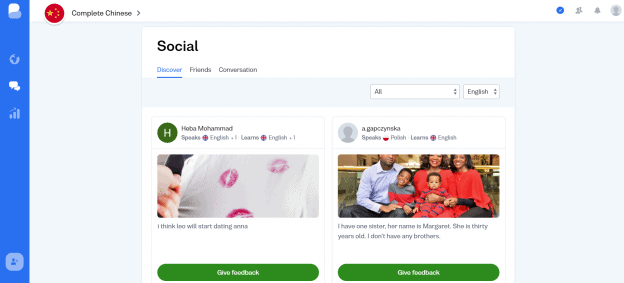
My experience with the social feature was almost entirely positive. I found it especially useful for getting feedback on my Chinese pronunciation. It feels like a much better way to get pronunciation feedback than through speech recognition technology.
I did also get some feedback that wasn’t entirely correct, but I suppose that’s just the nature of a feature like this.
Review
The Review section is where you… review!
It acts as a kind of dictionary of all the words you’ve learned so far with audio recordings, translations, and pictures.
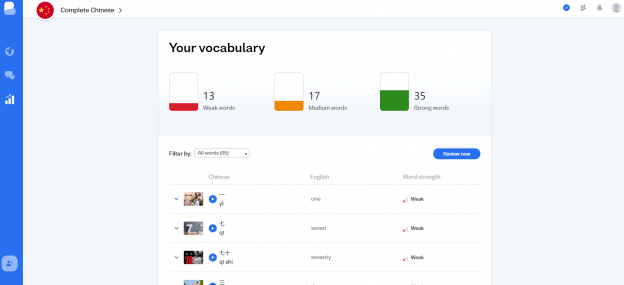
This is also where you can see Busuu’s spaced repetition algorithm at work. Words are grouped into categories from “Weak” to “Strong” depending on how often you use them correctly in exercises.
Clicking the Review Now button enters you into a review session of the words you need the most practice with.
I think this section is well done. Having an easy-to-use dictionary of the words you’ve learned with audio and translations is super helpful.
Busuu Chinese
As I mentioned earlier, Busuu isn’t great for learning Chinese. Here are some of the frustrations I experienced while using the program.
Languages like Chinese and Japanese are especially tricky for the fact that you really have to learn to use at least two writing systems. I didn’t like the way Busuu did this with Chinese.
The first frustration I came across was that there’s no support within the app for typing in Chinese characters or Pinyin. Granted, if you’re serious about learning Chinese, you’ll probably want to equip your computer with the ability to type in Chinese anyway.
I just wish there had been some direction or acknowledgment of the fact that I had to go seek out the correct software elsewhere.
Here’s one of the ways Busuu goes about teaching Chinese characters.
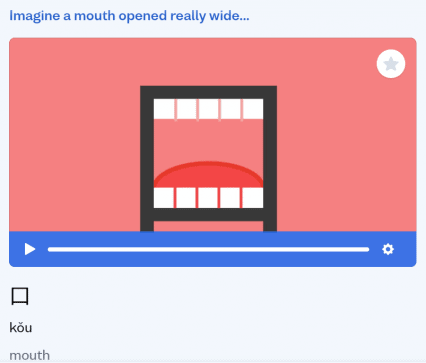
The above pictogram is great! I find this method for getting familiar with things like characters to be really helpful. Unfortunately, these are too few and far between in Busuu.
At first, you’re shown all new language items in both characters and Pinyin. Without any instruction for which to pay attention to, it’s of course much easier to focus on learning the Pinyin.
Unfortunately, I never came across any explanation of the different tones in Pinyin and how to pronounce them. I was left feeling lost when it came to pronunciation and eventually had to resort to Youtube for help. Presumably, this instruction comes later, but I needed it much sooner!
Busuu makes seemingly sporadic attempts at teaching you a few characters at a time, but it isn’t up to speed with the rest of the learning material. I was completely thrown off when all of a sudden the material was only written in characters because I had been relying heavily on the Pinyin.
Mistakes in the Material
This was the single most frustrating part of my experience using Busuu. I had only made it through the first couple of lessons before I had to contact Busuu support. The first problem I encountered was the following:

The correct answer provided by Busuu is exactly what I typed as my own response, yet it was repeatedly marked as incorrect.
Here’s another example:
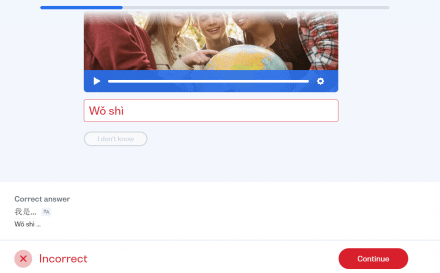
Super frustrating! There’s nothing quite as demotivating as being told you’re wrong no matter how right you are. It wasn’t just these two examples, either. By lesson four, I’d had four examples of the exact same problem with different phrases.
But wait, there’s more!
If you aren’t used to a language that uses tones, wrapping your head around them can be tricky. This is significantly more difficult if your learning material is frequently incorrect. I came across at least three instances of words with incorrect tones in the Busuu material.
Again, I’m a total newbie with Chinese, but these inconsistencies jumped out at me and made me doubt everything.
I should point out that neither Mateo nor I found any mistakes in the material for the Italian or German courses.
Busuu Support
Little errors like these are relatively common in digital language resources (though usually not so frequent), and there are a bunch of different ways companies go about rectifying them.
One of my favorite solutions to this problem is the Duolingo approach. Each exercise in Duolingo has a Report and Discuss options. The Discuss option allows users to make comments on the exercise and ask for clarification. The Report option is a straightforward way of reporting a faulty exercise.
Digital platform Chatterbug has a Live Chat feature that makes seeking support almost effortless.
Busuu requires you to fill out an email form and wait for a response. It works, I was able to get through to a member of their support team, but the process is clunky, time-consuming, and impersonal.
The support team confirmed that it looked like content errors on their side and that the relevant team would look into it.
Pricing
Busuu is totally free for those that are willing to register an account and just want to try it out.
There’s quite a bit of content available for free, but for access to all lessons and some additional content like a downloadable PDF of your vocabulary, you’ll need to purchase a Premium plan.
There are two types of paid plans on Busuu, Premium and Premium Plus.

The main differences are that you can access all of the languages and get a study plan with Premium Plus. A study plan essentially tells you how long it will take to reach your language goals given your rate of study. It also monitors your study habits.
The prices are as high as $13.99 for one month of a Premium Plus plan and as low as $5.41/month ($64.92) for a year-long subscription to the Premium plan.
Alternatives
The closest alternative to Busuu is probably Babbel. It’s available for a similar price and it functions in a similar way. The key differences between the two are that Babbel provides better opportunities to practice grammar points, but it doesn’t have Busuu’s social feature. Mateo and I also found Busuu to be slightly more engaging.
Babbel doesn’t offer any Asian language courses, but this is a better alternative to offering low-quality courses.
Duolingo is an alternative that is completely free, more game-like, and offers many more languages but is lower quality in some aspects. The audio quality is much worse on Duolingo, there’s no social feedback feature, and its Chinese course is also poorly done.
For those that are mostly interested in the social aspect of digital language learning, HiNative, HelloTalk, and Tandem are all free resources that are worth looking into.
As we’ve mentioned, Busuu isn’t great for learning Chinese. A solid alternative is Lingodeer, which was actually first developed with Asian languages in mind. The difference is quite noticeable.
There are also quite a number of other language learning apps worth checking out.
Final Thoughts
I really wanted to like Busuu more than I did. I was initially impressed with the layout and got excited about making progress in Italian and Chinese. Mateo also had only positive things to say about the design of the platform.
What threw me off the most was the Chinese course. If I had purchased a Premium plan with exclusively Chinese in mind, I would have been seeking a refund shortly after.
The Italian and German courses were of noticeably higher quality, but they still lacked some depth in grammar instruction and practice.
Fortunately, Busuu is free to try. If you aren’t learning Chinese and are interested in the platform, there’s no harm in trying it out for yourself.
As always, our top recommendations are different for each language. If you want to see our favorites for the language you’re learning, check out the table below.


I just had the same experience like DeamonserJ and I would’t suggest to anyone buying Premium. I did press the Cancel Premium Suscription a year ago, didn’t get a confirmation, but though it was okay. Now, a year later they charged my credit card with a year’s price! I don’t know what to do now. busuu support does not communicate but tells me I didn’t cancel the Premium.
That’s pretty lame of them. Unfortunately, it’s way more common than it should be with companies opting for the short-term gain of automatically renewing a subscription without notification or agreeing to refund. It just feels so short-sighted. Anytime a company says that a user agreed to their terms and conditions, it seems safe to assume they’re being sketchy.
Busuu business model is to steal your money silently continuing Premium subscription.
A year ago I needed to learn German. I tried several programs including Busuu.
I loved the idea of peer reviewing exercises, so I bought Premium for a year for 50% off.
And now, a year later, without email notification, they renewed Premium subscription for a year at full price!
After contacting the support team, I was told that I had read the Terms and Conditions, in which they are not required to notify before renewing the subscription. Thus, this company behaves like real thieves, “quietly” continuing premium subscription and charging the full cost of it.
So when buying a Premium subscription, be prepared to lose money in the future.
For me, I LOVED Busuu’s Japanese course… up till lesson 70 or something.
Before lesson 70, it’s mainly alphabets. They paired them nicely with pictograms and grammar, occasionally with a bit of cultural background info too. New words are always explained. The recordings are clear and slow-paced. I was very motivated and managed to complete them all in a week.
Starting from the “colour” topic, everything is thrown at your face. With little (or none) instructions, recordings blasting at you at full speed sometimes with Caucasian accent, exercises full of new words that you have never seen before, it’s just too much.
I agree on the Asian languages. Having studied Japanese at college level and also in Japan, I would say their lessons and translations have too many flaws. Some of the conversations feel too unnatural. For Spanish, French, and German on the other hand, the lessons are fantastic. I’m learning a lot. The paid version is worth it , just not for Japanese. The social feature is my favorite part.
I think that Busuu is an ok app but it has too many flaws to it. The word order sometimes are unusual and in Japanese, most of the sentences feel like it has been translated from Google Translate.
I completely disagree with you. The paid version is streets ahead of the free version. With the horror that is now Duolingo, which has been ruined by overzealous programmers, monetisation and extreme gamification that attracts children in droves, Busuu reminds me of what duolingo once was 3 or 4 years ago, only it’s better.